Frick Collection
|
| |
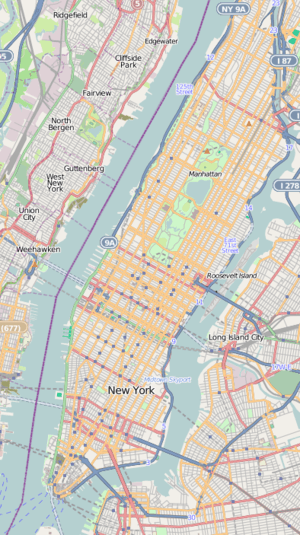 Location in Manhattan | |
| Established | 1935 |
|---|---|
| Location |
1 East 70th Street Manhattan, New York City |
| Coordinates | 40°46′16″N 73°58′02″W / 40.7712°N 73.9673°WCoordinates: 40°46′16″N 73°58′02″W / 40.7712°N 73.9673°W |
| Type | Art[1] |
| Director | Ian Wardropper |
| Public transit access |
Subways: Buses: M1, M2, M3, M4, M66, M72, M98, M101, M102, M103 |
| Website | http://www.frick.org |
The Frick Collection is an art museum located in the Henry Clay Frick House on the Upper East Side in Manhattan, New York City at 1 East 70th Street, at the northeast corner with Fifth Avenue. It houses the collection of industrialist Henry Clay Frick (1849–1919).
History
Henry Frick started his substantial art collection as soon as he started amassing his fortunes. A considerable amount of his art collection is located in his former residence "Clayton" in Pittsburgh, which is today a part of the Frick Art & Historical Center. Another part was given by his daughter and heiress Helen to the Frick Fine Arts Building, which is on the campus of the University of Pittsburgh.
The family did not permanently move from Pittsburgh to New York until 1905. Henry Frick initially leased the Vanderbilt house at 640 Fifth Avenue, to which he moved a substantial amount of his collection. He had his permanent residence built between 1912 and 1914 by Thomas Hastings of Carrère and Hastings. He stayed in the house until his death in 1919. He willed the house and all of its contents, including art, furniture, and decorative objects, as a public museum. His widow Adelaide Howard Childs Frick, however, retained the right of residence and continued living in the mansion with her daughter Helen. After Adelaide Frick died in 1931, the conversion of the house into a public museum started.
John Russell Pope altered and enlarged the building in the early 1930s to adapt it to use as a public institution. It opened to the public on December 16, 1935.
Further expansions of the museum took place in 1977 and in 2011. In 2014, the museum announced further expansion plans, but came up against community opposition because it would result in the loss of a garden. The Frick ultimately dropped those plans and is said to be considering other options.[2][3][4]
Collection
The Frick is one of the pre-eminent small art museums in the United States, with a high-quality collection of old master paintings and fine furniture housed in six galleries within the former residence. Frick had intended the mansion to eventually become a museum. Many of the paintings are still arranged according to Frick's design. Besides its permanent collection, the Frick has always organized small, focused temporary exhibitions.[5]
The collection features some of the best-known paintings by major European artists, as well as numerous works of sculpture and porcelain. It also has 18th century French furniture, Limoges enamel, and Oriental rugs.[1] After Frick's death, his daughter, Helen Clay Frick, expanded the collection, with a third of its artworks acquired since 1919. Although the museum cannot lend the two-thirds that belonged to Frick, as stipulated in his will, the Frick Collection does lend artworks and objects acquired since his death.[5]
Included in the collection are Jean-Honoré Fragonard's masterpiece The Progress of Love, three paintings by Johannes Vermeer including Mistress and Maid, two paintings by Jacob van Ruisdael including Quay at Amsterdam,[6] and Piero della Francesca's St. John the Evangelist.
Frick Art Reference Library
The Frick Collection oversees the nearby Frick Art Reference Library. The collections held at the library focus on art of the Western tradition from the fourth century to the mid-twentieth century, and chiefly include information about paintings, drawings, sculpture, prints, and illuminated manuscripts. Archival materials augment its research collections. Opened in 1920, the library quickly became a prime resource for students.[7]
Management
Attendance
According to The Art Newspaper, the Frick Collection has a typical annual attendance of 275,000 to 300,000.[8] About 35 percent of the visitors are non-English speaking.[5]
Governance
In 2011, Ian Wardropper succeeded Anne Poulet, who had run the Frick Collection as director since 2003.[9] Poulet took the position after Samuel Sachs II stepped down after running the institution for six years. Poulet was the first female director of the Frick.[10] During her time at the Frick Collection, Poulet increased the museum’s small board of trustees, adding 10 new members. She also introduced the Director’s Circle, a group of 44 members who each give a minimum of $25,000 a year to the Frick Collection, although many have made significantly larger contributions.[10]
Funding
The Frick Collection has an operating budget of $10 million and an endowment of $170 million (as of 1997).[11] Despite its large endowment, the institution still needs money to preserve the building.[5]
List of artworks
This is an incomplete list of the artworks of the collection, which mainly holds European artworks from before the 20th century.
| Artist | Span | Work | Date | Medium | Size | Purchase date | Accession number | Link |
|---|---|---|---|---|---|---|---|---|
| Lazzaro Bastiani | active c. 1425–1512 | Adoration of the Magi | 1470–1479 | tempera on poplar panel | 52.1 x 27.9 cm | 1935 | 1935.1.130 | [12] |
| Giovanni Bellini | c. 1430–1516 | St. Francis in Ecstasy | 1475–78 | oil on panel | 124.1 x 140.5 cm | 1915 | 1915.1.03 | [13] |
| Gentile Bellini | c. 1429–1507 | Doge Giovanni Mocenigo | 1478–1485 | tempera on poplar panel | ||||
| Francesco Botticini or Andrea Castagna | 15th century | The Resurrection | c.1440–1457 | tempera on poplar panel, cradled | ||||
| Agnolo di Cosimo (Bronzino) | 1503–1572 | Lodovico Capponi | 1550–1555 | oil on poplar panel | ||||
| Cimabue | c. 1240-c. 1302 | The Flagellation of Christ | c. 1280 | tempera on poplar panel | ||||
| Barna da Siena | active c.1330–1350 | Christ Bearing the Cross, with a Dominican Friar | c.1350–1360 | tempera on panel, cradled | ||||
| Duccio di Buoninsegna | c.1255-c.1319 | Temptation of Christ on the Mountain | 1308–1311 | tempera on poplar panel | ||||
| Gentile da Fabriano | c.1385-before 1427 | Madonna and Child with Saints Lawrence and Julian | 1423–1425 | tempera on panel, cradled | ||||
| Francesco Guardi | 1712–1793 | View of Venice | 18th century | oil on canvas | ||||
| Francisco Goya | 1746–1828 | Portrait of a Lady (María Martínez de Puga?) | 1824 | oil on canvas | ||||
| El Greco | 1541–1614 | Purification of the Temple | c.1600 | oil on canvas | ||||
| Francisco Goya | 1746–1828 | The Forge | c.1815–1820 | oil on canvas | ||||
| Francisco Goya | 1746–1828 | Don Pedro, Duque de Osuna | c.1790s | oil on canvas | ||||
| Francisco Goya | 1746–1828 | An Officer (Conde de Teba?) | c.1804 | ?) | ||||
| El Greco | 1541–1614 | St. Jerome | 1590–1600 | |||||
| Jean Auguste Dominique Ingres | 1780–1867 | Louise de Broglie, Countess d'Haussonville | 1845 | oil on canvas | ||||
| Diego Velázquez | 1599–1660 | King Philip IV of Spain | 1644 | oil on canvas | ||||
| El Greco | 1541–1614 | Portrait of Vincenzo Anastagi | 1571–1576 | oil on canvas | ||||
| François Boucher, workshop of | 1703–1770 | Girl with Roses | 1760s | oil on canvas | ||||
| François Boucher | 1703–1770 | A Lady on Her Day Bed | 1743 | oil on canvas | ||||
| François Boucher | 1703–1770 | Arts and Sciences: Fishing and Hunting | 1750–1753 | oil on canvas | ||||
| François Boucher | 1703–1770 | Arts & Sciences: Poetry and Music | 1750–1753 | oil on canvas | ||||
| François Boucher | 1703–1770 | Arts & Sciences: Painting and Sculpture | 1750–1753 | oil on canvas | ||||
| François Boucher | 1703–1770 | Arts & Sciences: Architecture and Chemistry | 1750–1753 | oil on canvas | ||||
| François Boucher | 1703–1770 | Arts & Sciences: Comedy and Tragedy | 1750–1753 | oil on canvas | ||||
| François Boucher | 1703–1770 | Arts & Sciences: Fowling and Horticulture | 1750–1753 | oil on canvas | ||||
| François Boucher | 1703–1770 | Arts & Sciences: Astronomy and Hydraulics | 1750–1753 | oil on canvas | ||||
| François Boucher | 1703–1770 | Arts & Sciences: Singing and Dancing | 1750–1753 | oil on canvas | ||||
| Gerard ter Borch | 1617–1681 | Portrait of a Young Lady | c.1665–1670 | oil on canvas | ||||
| Hendrick van der Burgh, attributed | active c.1627-after 1666 | Drinkers before the Fireplace | c. 1660 | oil on canvas | ||||
| Jan van de Cappelle, follower of | c.1624-c.1679 | View of the River Maas Before Rotterdam | c.1645–1665 | oil on oak panel, cradled | ||||
| Aelbert Cuyp | 1620–1691 | River Scene | date unknown | oil on oak panel | ||||
| Aelbert Cuyp | 1620–1691 | Cows and Herdsman by a River | After 1650 | oil on oak panel | ||||
| Aelbert Cuyp | 1620–1691 | Dordrecht: Sunrise | c. 1650 | oil on canvas | ||||
| Frans Hals | 1581/1585-1666 | Portrait of a Woman | 1635 | oil on canvas | ||||
| Frans Hals | 1581/1585-1666 | Portrait of a Man | c.1660 | oil on canvas | ||||
| Frans Hals | 1581/1585-1666 | Portrait of a Painter | early 1650s | oil on canvas | ||||
| Frans Hals | 1581/1585-1666 | Portrait of an Elderly Man | 1627–1630 | oil on canvas | ||||
| Pieter Bruegel the Elder | active 1551–1569 | The Three Soldiers | 1568 | oil on oak panel | ||||
| Gerard David | active c. 1460–1523 | The Deposition | c. 1510–1515 | oil on linen | ||||
| Anthony van Dyck | 1599–1641 | Sir John Suckling | 1632–1641 | oil on canvas | ||||
| Anthony van Dyck | 1599–1641 | Anne, Countess of Clanbrassil | 1636 | oil on canvas | ||||
| Anthony van Dyck | 1599–1641 | Frans Snyders | c.1620 | oil on canvas | ||||
| Anthony van Dyck | 1599–1641 | Margareta Snyders | c.1620 | oil on canvas | ||||
| Anthony van Dyck | 1599–1641 | James, Seventh Earl of Derby, His Lady and Child | 1632–1641 | oil on canvas | ||||
| Anthony van Dyck | 1599–1641 | Portrait of a Genoese Noblewoman | 1622–1627 | oil on canvas | ||||
| Anthony van Dyck | 1599–1641 | Ottaviano Canevari | 1627 | oil on canvas | ||||
| Anthony van Dyck | 1599–1641 | Marchesa Giovanna Cattaneo | 1622–1627 | oil on canvas | ||||
| Hans Holbein the Younger | 1497/1498-1543 | Sir Thomas More | 1527 | oil on oak panel | ||||
| Hans Holbein the Younger | 1497/1498-1543 | Thomas Cromwell | 1532–1533 | oil on oak panel | ||||
| Konrad Witz, circle of | c.1400-c.1447 | Pietà | c.1440 | tempera and oil on panel | ||||
| John Constable, Attributed | 1776–1837 | Salisbury Cathedral from the Bishop's Garden | 1826 | oil on canvas | ||||
| John Constable | 1776–1837 | The White Horse | 1819 | oil on canvas | ||||
| Francis Cotes | 1726–1770 | Francis Vernon | 1757 | pastel on paper affixed to canvas | ||||
| Thomas Gainsborough | 1727–1788 | Sarah, Lady Innes | c.1757 | oil on canvas | ||||
| Thomas Gainsborough | 1727–1788 | Grace Dalrymple Elliott | c.1782 | oil on canvas | ||||
| Thomas Gainsborough | 1727–1788 | Mrs. Peter William Baker | 1781 | oil on canvas | ||||
| Thomas Gainsborough | 1727–1788 | The Hon. Frances Duncombe | c.1777 | oil on canvas | ||||
| Thomas Gainsborough, attributed | 1727–1788 | 'Mrs.Charles Hatchett | c.1786 | oil on canvas | ||||
| Thomas Gainsborough | 1727–1788 | Richard Paul Jodrell | c.1774 | oil on canvas | ||||
| Thomas Gainsborough | 1727–1788 | Mall in St. James's Park | c. 1783 | oil on canvas | ||||
| Gilbert Stuart | 1755–1828 | George Washington | 1795–1796 | oil on canvas | ||||
| James McNeill Whistler | 1834–1903 | Symphony in Flesh Colour and Pink: Portrait of Mrs. Frances Leyland | 1872–1873 | oil on canvas | ||||
| James McNeill Whistler | 1834–1903 | Arrangement in Black and Gold: Comte Robert de Montesquiou-Fezensac | 1891–1892 | oil on canvas | ||||
| James McNeill Whistler | 1834–1903 | The Ocean | 1866 | oil on canvas | ||||
| James McNeill Whistler | 1834–1903 | Arrangement in Brown and Black: Portrait of Miss Rosa Corder | 1876–1878 | oil on canvas | ||||
| James McNeill Whistler | 1834–1903 | Harmony in Pink and Grey: Portrait of Lady Meux | 1881–1882 | oil on canvas | ||||
| Jean-Louis Lemoyne | 1665–1755 | Garden Vase | 1727–1728 | marble | ||||
| Étienne-Maurice Falconet | 1716–1791 | Fidelity Crowning Love | c. 1760 | marble | ||||
| John Lochee | 1751-c. 1791 | Bust of a Lady, Perhaps Mrs. Mary Robinson | 1775–1790 | marble | ||||
| Francesco Laurana | c.1430-c.1502 | Bust of a Lady | c.1430–1502 | marble | ||||
| Jean-Antoine Houdon | active 1741–1828 | The Comtesse du Cayla | 1777 | marble | ||||
| French | 18th Century | Louis XIV | 19th century | marble | ||||
| French | 18th Century | Friendship | c. 1770 | marble | ||||
| Jean-Antoine Houdon | active 1741–1828 | Armand-Thomas Hue, Marquis de Miromesnil | 1777 | marble | ||||
| Malvina Hoffman | 1887–1966 Primary | Bust of Henry Clay Frick | 1922 | white marble | ||||
| Francesco Laurana | c.1430-c.1502 | Beatrice of Aragon | 1471–1474 | white marble | ||||
| Early 16th Century | She-Wolf | early 16th century | bronze | |||||
| Riccio, known as Andrea Briosco, workshop of | 1470–1532 | Warrior on Horseback | early 16th century | bronze | ||||
| Roman | Late Sixteenth Century | Virtue Overcoming Vice | 1550–1600 | bronze | ||||
| Paduan | Early 16th Century | Cantering Horse | early 16th century | bronze | ||||
| Riccio, known as Andrea Briosco,workshop of | 1470–1532 | Goat | 16th century | bronze | ||||
| Venetian | Late 18th or Early 19th Century | Firedog with a Figure of Venus | 1775–1825 | bronze | ||||
| Venetian | Late 18th/Early 19th Century | Firedog with a Figure of Jupiter | 1775–1825 | bronze. | ||||
| Venetian | Early 16th Century | Naked Youth with Raised Arms | early 16th century | bronze | ||||
| Italian | 1600–1650 | She-Wolf | 1st half 16th century | bronze | ||||
| Bertoldo di Giovanni | 1420/1430-1491 | Heraldic Wild Man | 15th century | Bronze with extensive traces of gilding on base | ||||
| Caspar Gras | c.1590–1674 | Infant Faun | early 16th century | bronze | ||||
| Nuremberg | 1500–1550 | Satyr Mother and Child | 1575–1600 | bronze | ||||
| Hubert Gerhard, attributed | c.1550-1622/23 | Triton and Nereid | c. 1620 | bronze | ||||
| Hans Multscher, attributed | c.1400–1467 | Reliquary Bust of a Female Saint | c.1460 | bronze | ||||
| 19th Century | Reclining Antelope | 19th century | bronze | |||||
| François Girardon | 1628–1715 | The Grand Dauphin | 18th century | bronze | ||||
| French | Probably 18th century | Head of a Girl | 18th century(?) | bronze | ||||
| French | Probably 18th century | Head of a Boy | 18th century(?) | bronze | ||||
| French | 18th Century | Hercules and the Hydra | mid 17th century | bronze | ||||
| Jean Barbet | active 1475- d.1514 | Angel | 1475 | bronze | ||||
| Antoine Coysevox | 1640–1720 | Henri de la Tour d'Auvergne, Maréchal Turenne | Early 18th century | bronze | ||||
| Antoine Coysevox | 1640–1720 | Robert de Cotte | 1657–1720 | bronze | ||||
| François Girardon | 1628–1715 | Marie-Therese, Queen of France | 1648–1715 | bronze | ||||
| Netherlandish | 17th Century | Venus | 17th century | bronze | ||||
| Jacques Jonghelinck | 1530–1606 | The Duke of Alba | 1571 | bronze | ||||
| Frederic Remington | 1861–1909 | The Bronco Buster | 1919 | bronze | ||||
| Carl Augustus Heber | 1875–1956 | Medal | 1875–1956 | bronze | ||||
| Katherine Ward Lane Weems | 1899–1989 | Whippet | 1925 | bronze | ||||
| Louis-Simon Boizot | 1743–1809 | Peter Adolf Hall | 1775 | terracotta | ||||
| Augustin Pajou | 1730–1809 | Marie-Adelaide Hall | 1775 | terracotta | ||||
| Claude Michel Clodion | 1738–1814 | Zephyrus and Flora | 1799 | terracotta | ||||
| Claude Michel Clodion | 1738–1814 | Satyr with Two Bacchantes | 1799 | terracotta | ||||
| French | 18th Century (?) | Bust of a Young Girl | 18th century ? | terracotta | ||||
| Jean-Antoine Houdon | active 1741–1828 | Diana the Huntress | 1776–1795 | terracotta | ||||
| Gian Lorenzo Bernini | 1598–1680 | Head of an Angel | 17th century | terracotta | ||||
| Joseph Chinard | 1756–1813 | Portrait of Etienne-Vincent Marniola | 1809 | terracotta | ||||
Other featured artists include:
Selected highlights

 Titian, Portrait of a Man in a Red Cap, c. 1516
Titian, Portrait of a Man in a Red Cap, c. 1516
01.jpg) Hans Holbein the Younger, Thomas Cromwell, 1532 or 1533
Hans Holbein the Younger, Thomas Cromwell, 1532 or 1533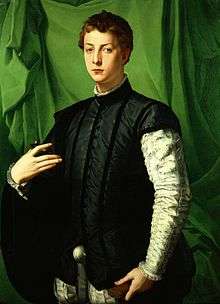 Agnolo di Cosimo, Portrait of Ludovico Cappon, 1551
Agnolo di Cosimo, Portrait of Ludovico Cappon, 1551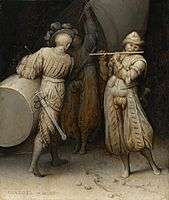 Pieter Bruegel the Elder, Three Soldiers, 1568
Pieter Bruegel the Elder, Three Soldiers, 1568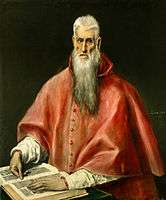 El Greco, Saint Jerome, c. 1590–1600
El Greco, Saint Jerome, c. 1590–1600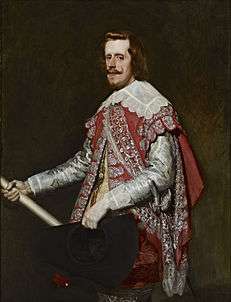
.jpg) Rembrandt, The Polish Rider, 1655
Rembrandt, The Polish Rider, 1655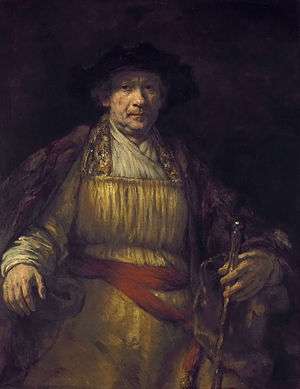 Rembrandt, Self-Portrait, 1658
Rembrandt, Self-Portrait, 1658 Jan Vermeer, Officer and Laughing Girl, 1657
Jan Vermeer, Officer and Laughing Girl, 1657 Jan Vermeer, Girl Interrupted at Her Music, 1658–1661
Jan Vermeer, Girl Interrupted at Her Music, 1658–1661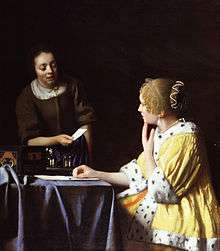 Jan Vermeer, Mistress and Maid, 1667
Jan Vermeer, Mistress and Maid, 1667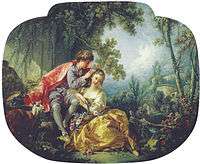 François Boucher, The Four Seasons (Spring), 1755
François Boucher, The Four Seasons (Spring), 1755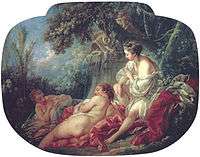 François Boucher, The Four Seasons (Summer), 1755
François Boucher, The Four Seasons (Summer), 1755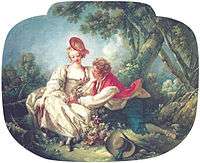 François Boucher, The Four Seasons (Autumn), 1755
François Boucher, The Four Seasons (Autumn), 1755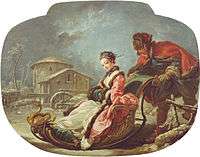 François Boucher, The Four Seasons (Winter), 1755
François Boucher, The Four Seasons (Winter), 1755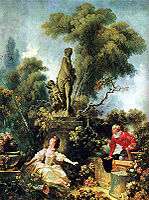 Jean-Honoré Fragonard, The Secret Meeting, 1771
Jean-Honoré Fragonard, The Secret Meeting, 1771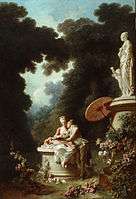 Jean-Honoré Fragonard, The Progress of Love - Love Letters, 1771-1772
Jean-Honoré Fragonard, The Progress of Love - Love Letters, 1771-1772 Francisco Goya, The Forge, 1817
Francisco Goya, The Forge, 1817 J.M.W. Turner, The Harbor of Dieppe, 1826
J.M.W. Turner, The Harbor of Dieppe, 1826
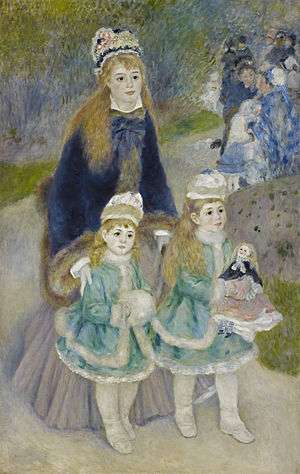 Pierre-Auguste Renoir, Mother and Children (La Promenade), 1875–76
Pierre-Auguste Renoir, Mother and Children (La Promenade), 1875–76
See also
References
Notes
- 1 2 "Frick Collection: About". ARTINFO. 2008. Retrieved 2008-07-28
- ↑ Pogebrin, Robin (June 9, 2014) "Frick Seeks to Expand Beyond Jewel-Box Spaces" The New York Times
- ↑ Pogebrin, Robin (November 9, 2014) "Frick’s Plan for Expansion Faces Fight Over Loss of Garden" The New York Times
- ↑ Pogebrin, Robin (June 3, 2015) "Frick Museum Abandons Contested Renovation Plan" The New York Times
- 1 2 3 4 Carol Vogel (September 7, 1998), Director Tries Gentle Changes For the Frick New York Times.
- ↑ "Jacob van Ruisdael". Frick Collection.
- ↑ John Russell (November 10, 1984), Helen Clay Frick Dies At 96 New York Times.
- ↑ Julia Halperin (January 11, 2014), Frick’s finch lays golden egg The Art Newspaper.
- ↑ Kate Taylor and Carol Vogel (May 19, 2011), The Frick Collection Names a New Director New York Times.
- 1 2 Carol Vogel (September 22, 2010), Director of Frick Collection Will Retire in Fall of 2011 New York Times.
- ↑ Carol Vogel (May 13, 1997), Frick Finds Its Director In Detroit New York Times.
- ↑ http://collections.frick.org/view/objects/asitem/items$0040:37
- ↑ "Giovanni Bellini, St. Francis in the Desert". The Frick Collection. Retrieved 19 January 2014.
Further reading
- Bailey, Colin B. (2006). Building the Frick Collection: An Introduction to the House and its Collections (PDF). New York: Frick Collection, in association with Scala Publishing. p. 128. ISBN 1-85759-381-2. Retrieved 2013-11-08.
- Bernice Davidson, Susan Galassi. Art in the Frick Collection : Paintings, Sculpture, Decorative Arts. Harry N Abrams. 1996. ISBN 978-0810919723
- Scala Publishers. Frick Collection: Handbook of Paintings. Scala Arts & Heritage. 2006. ISBN 978-1857593280
- Bernice Davidson, Edgar Munhall, Nadia Tscherny. Paintings from the Frick Collection . Harry N. Abrams. 1991. ISBN 978-0810937109
- Colin B. Bailey. Fragonard's Progress of Love at The Frick Collection. GILES. 2011. ISBN 978-1904832607
- Joseph Focarino. The Frick Collection, An Illustrated Catalogue. Volume IX: Drawings, Prints, and Later Acquisitions. Frick Collection. 2003 ISBN 978-0691038360
External links
| Wikimedia Commons has media related to Frick Collection. |